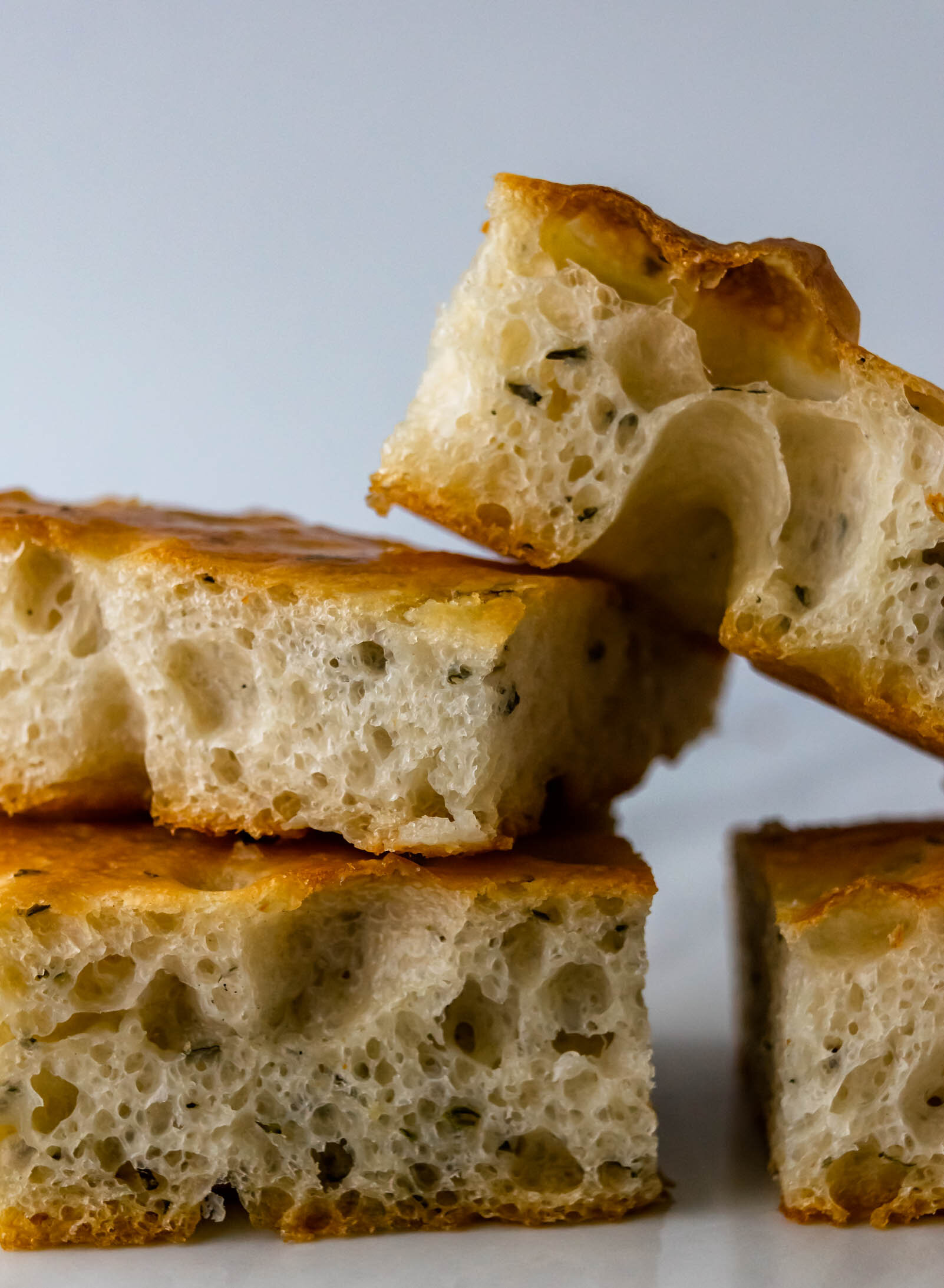Fantastic Focaccia

While this recipe takes time, it is well worth the wait- out of several popular recipes, this recipe won the highest marks in a side-by-side metareview.
The texture and flavor are amazing! You’ll want to rough-chop any herbs or vegetables so they are not too small, as they can burn and go bitter otherwise. Some toppings I like to add (before baking) are red onion, fresh rosemary, black olives, capers, sundried tomatoes, and halved cherry tomatoes. Since this makes a very big focaccia, you can try multiple combinations of toppings! You can store it by wrapping it in baking parchment inside an airtight bag or container to preserve texture. Gently toast or reheat any leftover focaccia before serving. Alternatively, wrap tightly to freeze, then defrost and reheat before serving.
This recipe was taken from this recipe from “Salt Fat Acid Heat” by Samin Nosrat; there is additional information about the process in the original recipe.. -Will B.
- ~25 portions
- 120+ minutes
- 30 minutes
Ingredients
Convert imperial/metric measurements
For the dough:
- 2½ cups (600 grams) lukewarm water
- ½ teaspoon active dry yeast
- 2½ teaspoons (15 grams) honey or agave nectar
- 5 1/3 cups (800 grams) all-purpose flour
- 2 tablespoons (18 grams) Diamond Crystal Kosher salt or 1 tablespoon fine sea salt
- ¼ cup (50 grams) extra-virgin olive oil, plus more for pan and finishing
- Flaky salt for finishing
For the brine:
- 1½ teaspoons (5 grams) Diamond Crystal Kosher Salt
- ⅓ cup (80 grams) lukewarm water
[Optional toppings]: There are some popular toppings such as sliced onions, rosemary, and sweet peppers, but you can add anything you want as long as you don’t over-crowd the toppings, or add too much additional moisture.
Directions
- In a medium bowl, stir together water, yeast, and honey to dissolve.
- While the yeast “wakes up”, in a very large bowl (>5L), whisk the flour and salt together.
- Add yeast mixture and olive oil to the dry ingredients in the large bowl. Stir with a rubber spatula until just incorporated, then scrape the sides of the bowl clean and cover with plastic wrap.
- Leave out at room temperature to ferment for 12 to 14 hours until at least doubled in volume.
- Spread 2 to 3 tablespoons oil evenly onto a 18-by-13 inch (46-by-33 cm) rimmed baking sheet. Use a spatula or your hand to release it from the sides of the bowl and fold it onto itself gently, then pour out onto pan. Pour an additional 2 tablespoons of olive oil over dough and gently spread across. Gently stretch the dough to the edge of the sheet by placing your hands underneath and pulling outward. The dough may shrink back a bit, so you can try stretching it again once or twice after letting it rest 5~10 minutes.
- Dimple the dough by pressing the pads of your first three fingers in at an angle.
- Make the brine by stirring together salt and lukewarm water until salt is dissolved. Pour the brine over the dough to fill dimples.
- Proof focaccia (let it rest at room temperature) for 35~45 minutes until the dough is light and bubbly.
- 15 minutes before your proof is done, preheat your oven to 450°F (235°C). If you have a baking stone, place it on rack. Otherwise, invert another sturdy baking sheet and place on rack; this will help ensure a crispy brown bottom crust.
- [Optional] Right before you put it in the oven, you can gently add your desired toppings to the focaccia. Don’t put too many things, as it can add extra moisture and change the cook time.
- Sprinkle focaccia with flaky salt then bake for 25 to 30 minutes directly on top of stone or inverted pan until bottom crust is crisp and golden brown when checked with a metal spatula. If the top crust isn’t already nicely browned, you can place the focaccia on the upper rack and bake for 4~7 minutes more, keeping a close eye on it so it doesn’t burn. It will continue to cook slightly after you remove it from the oven, so don’t let it go too far.
- Remove from oven and brush or douse with 2 to 3 tablespoons oil over the whole surface (don’t worry if the olive pools in pockets, it will absorb as it sits). Let cool for 5 minutes, then release focaccia from pan with metal spatula and transfer to a cooling rack to cool completely.
